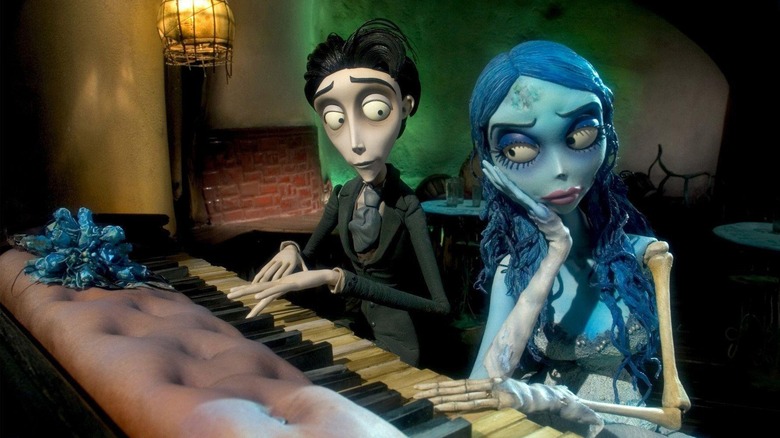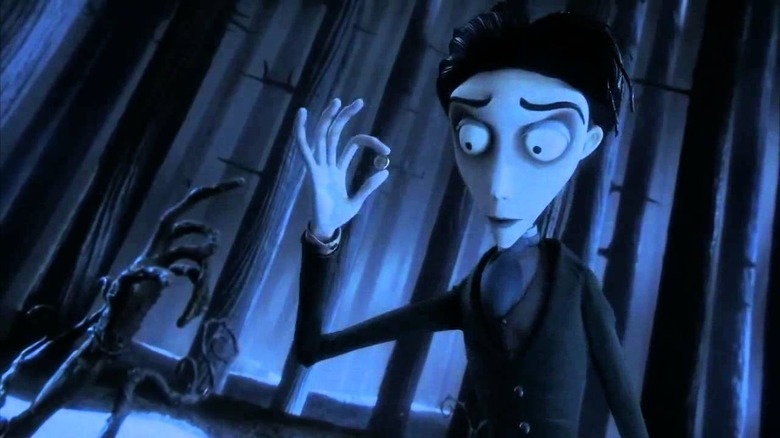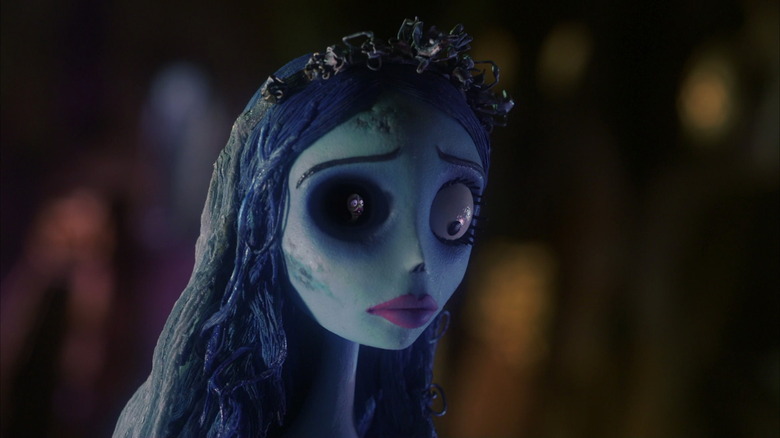Tim Burton's Corpse Bride Found Its Roots In A Real-World Folktale
Victor (Johnny Depp) is betrothed to Victoria (Emily Watson). Their marriage is intended to be purely transactional — his new-money parents will bequeath a sizable dowry to her parents, whose old-money fortune is nearly gone. But Victor and Victoria have an instant bond. They are shy in the same way, and find in each other kindred, introverted spirits. Victor, however, becomes so nervous during the wedding rehearsal that he flees and takes shelter in a nearby glade, where he continues the rehearsal to the gnarled trees around him. He slips the wedding ring onto a nearby branch, declaring it his bride — unaware that the branch is, in fact, the bony hand of a corpse buried in that glade. Soon, Emily (Helena Bonham Carter), a resurrected bride in a wedding gown, rises from the ground. She takes Victor to the afterlife — a far more lively and colorful place than the land of the living — where they must suss out what it means for a living person to be married to a dead one.
So goes the story of Tim Burton's 2005 animated film "Corpse Bride." Despite its macabre premise, "Corpse Bride" is a sweet and melancholy tale of outsiders and lost love. In many ways, it's a quintessential Tim Burton film, including every one of the filmmaker's hallmarks: Shy outsiders, a fascination with death and the macabre, wild production design, stop-motion animation, a Danny Elfman score, Johnny Depp and/or Helena Bonham Carter, a fairy tale-like premise, and a final release from drama straight out of a goth kid's journal.
The fairy tale aspect, however, might be one of the more fascinating parts of "Corpse Bride," given that story comes from an actual piece of Jewish folklore.
The Finger
The story for "Corpse Bride" dates back to the 16th century and was originally recorded as part of a compendium of Jewish folk tales called "Shivchei Ha'ari." (Hebrew editions of the book are available to this day.) Partly presented as parables, the volume recounts the adventures of Rabbi Isaac Luria (1534 – 1572), aka The ARI, one of the more prominent Talmudic scholars of his time. He's been considered "the father of modern Kabbalah," and you can visit his grave in the Old Cemetery of Safed in Israel.
In the original version of the story, Rabbi Luria is joking around with a ring and marriage vows in the woods. He places the ring on a branch, only to discover the branch is the corpse of a dead woman who rises from her grave, shrieking and declaring Luria to be her husband. In the original tale, the corpse bride is not a lovelorn outsider, but a terrifying specter of death: She wails and insists on consummating her marriage with a living man. "The Finger" is not a tale of finding love, but a ghost story.
Rabbi Luria eventually asserts control over his new bride. She retracts her requests, and they take their unconventional marriage to the rabbinic court and ask for a ruling on a marriage between the living and the dead. The court sides with Rabbi Luria's argument that the marriage couldn't possibly be legitimate, and, wailing, the corpse bride collapses into a pile of bones. (A modern version of this tale, "The Finger," can be found in the 1987 book "Lilith's Cave: Jewish Tales of the Supernatural" by Howard Schwartz.)
Updating the Tale
According to an article in The Jewish News of Northern California, Tim Burton took interest in the "Corpse Bride" story when the film's executive producer, Joe Ranft, brought it to his attention. Burton, who worked for Disney early in his career, saw potential for a modern fairy tale in the Disney mold in the Jewish folk tale and adapted it by setting his version in Victorian England.
For Burton — and, indeed, for many American filmmakers — fairy-tale iconography slants aggressively toward the western European. Many Disney animated films are based on Western European folk tales: The version of "Cinderella" we know hails from Germany, "Sleeping Beauty" is a 16th-century English tale, and "Frozen" was inspired by Hans Christian Andersen. And although the characters' religion is not mentioned in "Corpse Bride," there are Christian churches and a stern bishop voiced by Christopher Lee, implying that the characters are Anglican.
As for Burton, he's never been too forthcoming about his own religion, other than to say he was raised in a boring, passionless Protestant church, and that he is no longer religious. So his motivation for adapting a Jewish tale was likely based on what he, an American raised in a Protestant church, considered to be "classic" fairy tale imagery. It's unlikely that he felt the need to make the story a Christian allegory — or, even worse, to erase its Jewishness. Because, to artists like Burton, Victorian England felt like a "default" location for fairy tales, putting "Corpse Bride" in that setting was an attempt to universalize the story. This transmigration of an "other" Jewish tale to a "default" Christian tale reveals an inherent prejudice in American views of culture, faith, and folklore. But I do not put the blame on Burton. That goes to fairy-tale cinema at large. At the very least, Disney, Pixar, and other studios have made recent strides in including more cultures in their fairy tale stories, leading to films like "Mulan," "Moana," "Encanto," "Coco," and more.
Nevertheless, "Corpse Bride" remains a sweet, appealingly maudlin, and surprisingly heartfelt little haunted house oddity for strange little kids, and I recommend you see it. I would also recommend reading "Lilith's Cave" to gain a broader perspective on the cultural exchange at work with the film.


